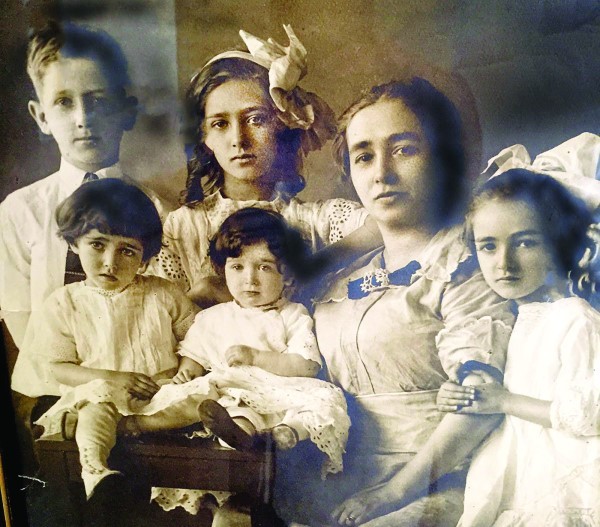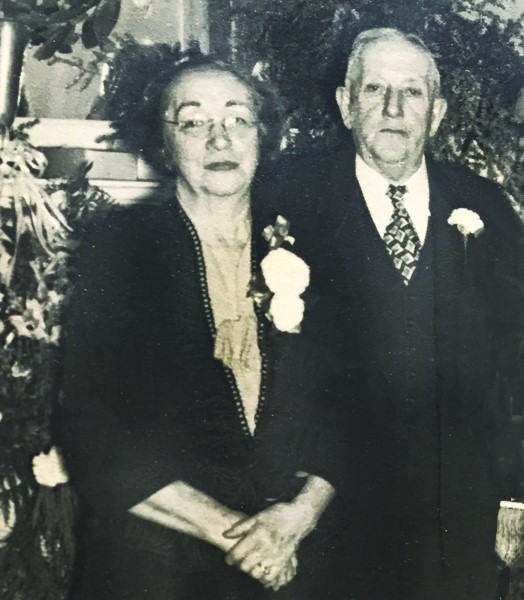The pull of the plaque
Following the twists and turns of family history
Heading to lunch recently with a friend, I suggested we dine at Sagres Restaurant on Columbia Street in the heart of Portuguese Fall River and its many tenements.
The chitchat was great and the food was fabulous. But I also was feeling another vibe. This was once a Jewish part of town, and, in the early years of the 20th century, my grandfather Michael Bakst lived on Columbia Street with his wife, the former Katie Levy, and their growing family.
I’d been thinking about Michael, who came from what is now Belarus. He owned men’s clothing stores and was the uncle of celebrity gossip columnist Walter Winchell. Michael died in 1946 when I was only 2, and now he’d suddenly jumped back into my life.
And so had several long-departed relatives from my mother’s side, Fall River’s enormous Horvitz family.
This is the pull of history across the decades, by something as simple and as powerful as a rectangular brown and gold memorial plaque, typically metal, fashioned for display in synagogues as a reminder of those who came before us.
But what if those synagogues fold or retreat to smaller premises?
This summer, I read an article in the New Jersey Jewish News about rescuing and relocating old plaques there, and it got me thinking about Fall River. . .
Almost five years ago, the once-flourishing but now shriveled Congregation Adas Israel, chartered in the 1890s and the last of several Orthodox shuls that once dotted the city, sold the building that had been its home since 1959 when it moved from Pearl Street, near Columbia, just below downtown. The more modern building, now a church, is in the city’s upscale Highlands section, to which large numbers of Jews had gravitated over the years.
The few remaining Adas Israel members moved into rented space in Conservative Temple Beth El on High Street, where I grew up. In fact, they moved into what had been the board room, with a picture of my late father, Lester Bakst, a temple president, still on the wall.
The Adas Israel folks dismantled and moved their memorial plaques along with those of the old Quarry Street shul, which was a Horvitz family preserve that, in the end, threw in with Adas Israel. In fact, there were also memorial plaques from the old Union Street shul. Jeffrey Weissman, current Adas Israel president, has always held out hope that the various plaques would be reassembled and displayed at Beth El.
It bothered me to think that plaques memorializing relatives close to me could be sitting in the obscurity of boxes or plastic crates in storage somewhere at the temple. Indeed, it turned out that several more cartons were languishing in a cinder block shed at an Orthodox cemetery amid boxes of old prayer books and dinnerware, near a table piled with old photos.
Weissman generously joined me in sifting through the plaques stored at the temple and, for this occasion, hauled into the vestry for our perusal. And out popped a plaque for Michael Bakst. I was delighted but not surprised. I’d always understood that he had belonged to Adas Israel in its old Pearl Street days.
At the cemetery shed, we found a cache of Horvitz plaques, though not for my maternal grandmother, Dora Horvitz, who died in 1955 when the Quarry Street shul, in the city’s Flint section, was still in business. Neither did we find a plaque for my maternal grandfather, Morris Horvitz Sr. When Quarry Street folded, he joined Adas Israel. His funeral was held there in 1963.
I would later discover that plaques for both Dora and Morris are mounted in Temple Beth El’s sanctuary, presumably years ago on the initiative of my parents or other close relatives.
When I told my cousin Cynthia Resnick Schwartz that I’d seen a plaque for her great-grandfather, Mendel Horvitz, at the cemetery shed, she immediately wanted to rescue it.
With permission, we went and retrieved it along with plaques of several other relatives to give to descendants who we knew wanted them. They included those of my grandfather’s brother, Solomon Horvitz, and their sister, Gertrude Horvitz Sacknoff, and her husband Osher. In 1900, Solomon and Gertrude – to me she was (Great) Aunt Gitell – were among the first Horvitzes to immigrate from the Ukraine.
Three other Horvitz-related plaques we brought out went to cousin Linda Smith Kessler, who has installed them at her Pawtucket synagogue, Congregation Ohawe Sholam.
I had Michael Bakst’s plaque installed at my own Temple Habonim in Barrington, and I have asked that one be made and displayed for my Grandmother Bakst, who died in 1958 when I was pushing 14 and who apparently has no plaque anywhere.
My father, Lester, looked exactly like Michael. Lester also looked very much like his cousin, Walter Winchell, son of Michael’s sister, Jennie.
Winchell’s Sunday night radio broadcasts were the soundtrack of our family’s life. Winchell later also was on television, and when he was launching a new show in 1956 my father bought my grandmother a new, large television to watch it.
The search for the plaques prompted me to dip into family history. I saw that Michael was born in 1873 and may have landed in New York by 1890. Fall River city directories began listing him and the first of his businesses in 1897.
Initially he was a boarder. Then he and Katie lived in tenements on Columbia Street, then near St. Anne’s Hospital and eventually had private homes in the more upscale Highlands neighborhood.
He died of cancer on June 24, 1946. His funeral was held in the house, with a rabbi from the Union Street shul officiating. This could mean Michael was a member there or, perhaps more likely, the rabbi was filling in.
Michael was buried in the Temple Beth El Cemetery in a plot undoubtedly purchased by my father. Katie and my parents eventually would join Michael there.
So many recollections, and now here I was, in 2017, with Adas Israel’s Jeffrey Weissman, sifting through these loose, lonely Orthodox plaques that had wound up at the temple.
I was so happy to extricate Michael’s and bring it to Temple Habonim, which my wife Elizabeth and I joined when we arrived in Barrington in 1968 and still belong to even though we now live in Providence.
At Yom Kippur services, Elizabeth and I were walking around, looking for seats. We wandered over toward the wall now bearing the plaque, and I said lightly, “Let’s sit here with Grandpa.”
So we did. And the services started, and then a remarkable thing happened. A calm washed over me, and it felt good.
Grandpa had come home.
M. CHARLES BAKST is a retired Providence Journal political columnist.
WRITER’S NOTE: Building on earlier research by Stuart Liss and Edward Kaplan, with a fresh boost from my brother, Arthur, and assistance from David Davies, I learned much more about Grandpa Bakst, who died when I was 2, than fits here. But I also found maddening gaps or contradictions. On both sides of my family, I regret I spent so little time drawing out grandparents or other relatives I did know, about their earlier days. Don’t make this mistake. I resolve to volunteer more to my own daughters or granddaughters about my life and our family – and to write a detailed memo as a resource.













